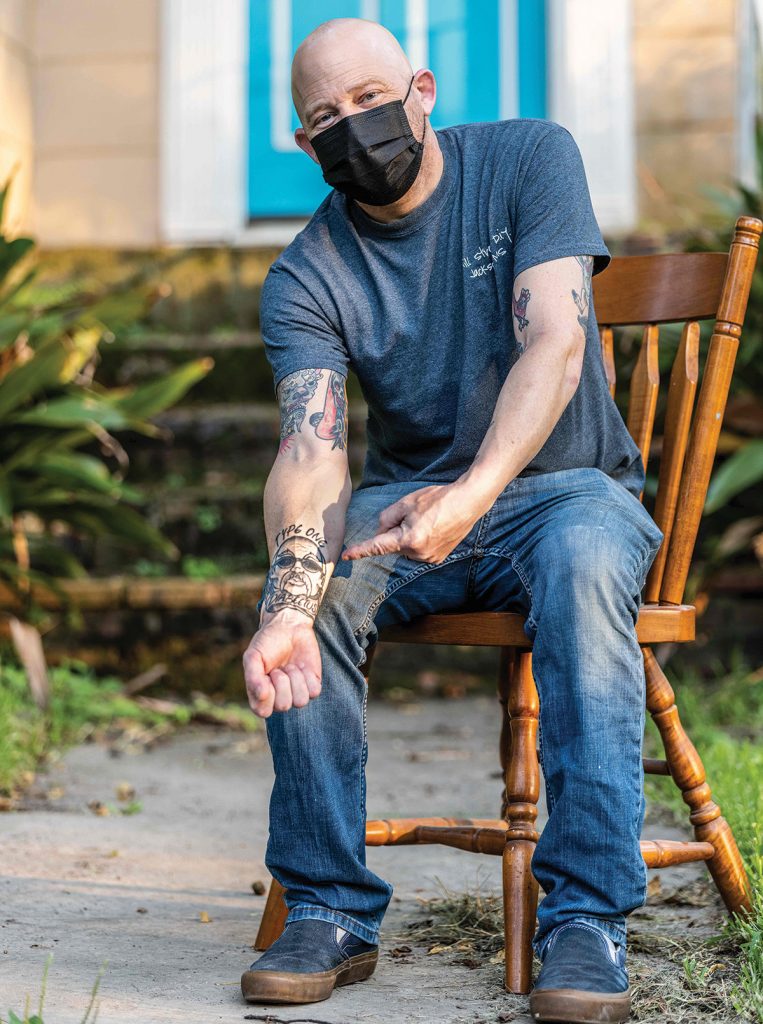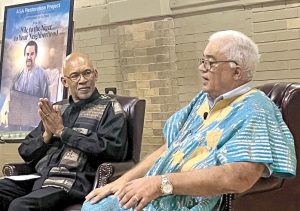By Jerry Mitchell
Mississippi Center for Investigative Reporting
Frank Henn knew something was wrong on his Spring Break trip to the Mississippi Gulf Coast.
“I was thirsty,” recalled the 46-year-old Jackson resident. “I had to stop at a gas station every 20 minutes to get a Coke and use the bathroom.”
Within a month, the 17-year-old was hospitalized, joining the ranks of 1.6 million Americans diagnosed with Type 1 diabetes. That number is expected to more than triple over the next three decades.
“All I could think was the word ‘die’ is in this disease,” Henn said. “I’m not going to make it through this.”
Inside the hospital, he learned how to count calories, prick his finger, test his blood sugar level, and inject himself with insulin.
The diet was precise -– 2,500 calories a day – but battling the disease proved anything but precise, where one misstep could mean an early grave, he said. “When you’re diabetic, every decision you make will keep you alive or kill you.”
“Do I buy insulin or do I buy food?”
Henn said people would tell him all he needed to do was change his diet, and then he wouldn’t have to use insulin anymore.
That, of course, is a lie, he said. “What I wish for society to understand about diabetes is that it happens because our bodies are broken. We didn’t eat too much cake. We didn’t drink too much lemonade.”
Type 1 diabetes is a chronic condition caused by an autoimmune reaction that destroys the cells in the pancreas that make insulin, a hormone needed to allow sugar (glucose) to enter cells to produce energy.
With Type 2 diabetes, too much glucose is circulating in the bloodstream, and those high blood sugar levels can damage circulation and organs. The pancreas produces enough insulin but the cells in the body have become resistant to it. More than 30 million Americans suffer from Type 2.
By 2050, the number battling all forms of diabetes could reach 1 in 3.
Dr. Rick deShazo, distinguished professor emeritus at the University of Mississippi Medical Center and adjunct professor of medicine at the University of Alabama School of Medicine in Birmingham, said genetics plays a huge role in Type 1 diabetes, which mainly strikes children.
“Many of them show up in the emergency room in a coma,” he said. “You can die of it very easily if it’s not taken care of.”
Henn said a number of his relatives suffer from the same Type 1 diabetes he battles.
For years, employers turned him away because they didn’t want him on their health insurance policies. Financial setback after setback followed.
In 1992, he said he spent $18 a month for insulin. By 2010, that cost had ballooned to $800 – $200 more than his monthly mortgage payment.
“What happens to my house when I can’t pay my mortgage because I can only afford my insulin?” he asked. “When you’re younger, an extra $50 is hard to come by, much less another $800.”
Supplies added hundreds more to those expenses, and he did all he could to scrimp. He reused finger stickers “until they put a big hole” in him, he said.
There are unexpected costs as well. When he broke his ankle skateboarding, his insurance company refused to cover his $15,000 emergency room bill. The reason given? The broken ankle was related to diabetes, which the company didn’t cover because it was “pre-existing.”
Financial decisions often impact health, he said. “Do I buy insulin or do I buy food? Can I afford a good diet? Or do I get a two for $1 hot dog because I just bought insulin?”
As a result, diabetics face a dangerous dilemma: stop paying bills so they can afford their insulin or ration that insulin, playing Russian roulette with their body.
Nationwide, 7 million Americans depend on insulin, and more than a fourth of them ration the drug because they can’t afford it.
After the Affordable Care Act became law in 2010, insurance companies could no longer exclude people for previous health conditions. Starting in 2014, new individual plans were not allowed to deny individuals coverage, charge them more because they have diabetes or exclude coverage for treatment of a pre-existing condition, such as treatment for diabetes.
“That was the first time in my life that anybody had covered my diabetes,” he said.
Even with insurance, insulin ran up to $570 a month, he said. “You always have to have a job, or you literally die. I’ve almost lost my house three times.”
And if you accidentally drop your glass insulin bottle, he said, “you better come up with $1,200.”
The insurance enabled Henn to finally afford to see an endocrinologist, who put him on more advanced insulins.
Henn changed his diet, too, eliminating processed foods, he said. “Healthy food is more expensive.”
He made monthly payments to purchase a $2,000 continuous glucose monitor that would constantly check his blood sugar levels. That enabled him, he said, to begin to understand what food was doing to his body (“a salad versus a burger”).
He later drained all of his savings to pay a doctor $5,000 for an insulin pump, which could add the hormone as needed. He began using his smartphone with the glucose monitoring system to tell the pump how much insulin was needed.
Fighting A War Against Diabetes
In spite of that technology, the silent scourge of diabetes continued to ravage his body, his diseased pancreas attacking his kidneys, his eyes, and other organs.
In January 2020, he faced another crisis. His lifesaving insulin skyrocketed from $30 for three months to $575 with insurance. After he managed to get the medicine for a cheaper price by mail ($125), he hit a new snag when the Postal Service announced it was slowing down mail delivery.
He said he worried about getting his critical insulin on time. “Now you’re relying on a whole other service to get you your medication.”
Those fighting the war against diabetes often feel beaten down, he said. He confessed that he has battled mood swings and anger.
“Nine out of 10 times, you’ll take it out on a co-worker, a wife, or a friend,” he said. “It ruins relationships and jobs.”
His wife, Liz Nosen, agreed that diabetes takes its toll, saying the disease has been the “constant third party” in their relationship. “It’s always something that you both need to attend to,” she said.
“If things go wrong, he won’t be able to attend to it.”
She recalled waking one night, and “his breathing sounded funny.”
She asked if he was OK, and he didn’t answer. She turned on the lights and realized he was having a seizure. She called 911, and the ambulance arrived.
Night times are the scariest, she said, “because he’s going unconscious and so are you.”
Henn said diabetes is a disability, even though it isn’t recognized as one by employers. “You can’t take the day off,” he said. “You can’t have a sick day because of diabetes. Nobody understands how hard it is.”
In November, his kidneys began to fail. He went through a month of tests and interviews, hoping to qualify for a pancreas and kidney transplant.
On Jan. 4, he began dialysis, which meant he spent all night hooked up to a machine. The treatment proved both painful and debilitating.
That same day, he learned he qualified for the transplant wait list at the University of Mississippi Medical Center. He was one of eight possible patients in line to get a pancreas and kidney transplant.
The waiting began.
Forging A New Life
Henn said he’d heard stories of how some on the list had waited seven years, and some died before hearing their names called, he said. “It’s like a lottery.”
By Jan. 26, he had fallen into a pit of depression, wondering how he could keep living this way. “Dialysis,” he said, “made diabetes seem easy.”
The next day, Henn got the call from UMMC. He got to the hospital in less than an hour.
When he woke up from surgery, he no longer recognized his own life. His blood sugar was normal; so were all his vital signs. He no longer needed insulin.
“All my numbers are like I’m 15-years-old again,” he said. “I’m completely healthy. I’ve never really known it before.”
Nosen said diabetes, the third party in their relationship, has gone away, at least for now.
She no longer worries when she goes to sleep that her husband might never wake up. “It’s like a future you never thought could exist,” she said.
In April, he took UMMC officials up on an offer and penned a letter to the donor family.
“I am extremely sorry for the loss of your loved one. I know it’s hard, and they will be with you always,” he wrote. “I want to thank you, and let you know how much this generous gift of a pancreas and kidney has changed my life … 30 years of taking shots of insulin, and dealing with everything that comes with diabetes. The pain and frustration of daily dialysis treatments. All gone due to my HERO and the love that surrounded them. I could not begin to describe the weight that has been lifted from me.”
He hopes one day he can thank the family in person, but in the meantime, he is forging a new life on a new path.
He no longer has to monitor his blood sugar. He no longer has to inject himself with insulin. He no longer has to get shots in his eyes to prevent blindness.
And if he wants to eat a piece of cake, he can.
The tradeoff? He has no immune system, so he takes care in this pandemic to wear a mask, wash his hands, and be careful.
“What do you do without diabetes?” he asked. “What do you do?”
He paused.
“I’m still learning.”
Email Jerry.Mitchell@MississippiCIR.org.
You can follow him on Facebook, Twitter or Instagram.
This story was produced by the Mississippi Center for Investigative Reporting and funded in part by the Fund for Investigative Journalism. It also was produced in partnership with the Community Foundation for Mississippi’s local news collaborative, which is independently funded in part by Microsoft Corp. The collaborative includes MCIR, the Clarion Ledger, the Jackson Advocate, Jackson State University, Mississippi Public Broadcasting, and Mississippi Today.






